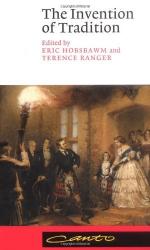
|
| Name: _________________________ | Period: ___________________ |
This quiz consists of 5 multiple choice and 5 short answer questions through Chapter 1, Introduction, Inventing Traditions.
Multiple Choice Questions
1. The author also believes that new invented traditions have practices that are _______, like saying the American pledge of allegiance.
(a) Impulsory.
(b) Excitatory.
(c) Voluntary.
(d) Compulsory.
2. Hobsbawm asserts that exceptions to the decline in question 22 exist in all of the following areas except ______.
(a) Armed forces.
(b) Law.
(c) Administration.
(d) School.
3. Hobsbawm asserts that the overtly or tacitly accepted rules of traditions must have a ______ nature.
(a) Symbolic.
(b) Antibolic.
(c) Transitional.
(d) Archetypal.
4. In particular, the author suggests that historians pay attention to the creation of all of the following concepts except _______.
(a) Nation.
(b) United Nations.
(c) Nation-state.
(d) National symbols.
5. Hobsbawm suggests that the 19th century _____ ideology of social change had to have a new tradition to support it, since it didn't fit in old patterns.
(a) Conservative.
(b) Sectarian.
(c) Liberal.
(d) Religious.
Short Answer Questions
1. The author suggests that one of the aspects of _______ is the fact that they have an ideological function.
2. The author suggests that all of the concepts in question 26 rest on what he calls social ________.
3. Hobsbawm asserts that one of the factors that makes _______ unique is that they do not allow for variance in practice.
4. The author states that the invention of tradition involves _______ and ritualization with reference to the past.
5. According to the book, the basic type of invented tradition was called ______, which outlined the historical practices of a particular group.
|
This section contains 230 words (approx. 1 page at 300 words per page) |

|




